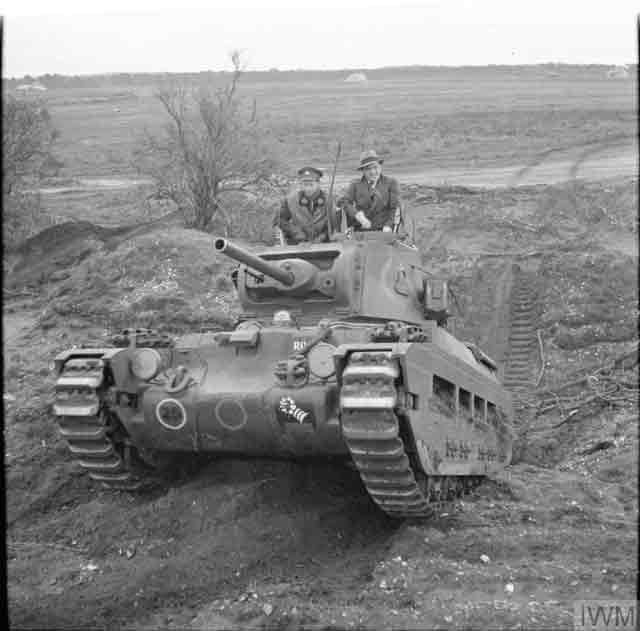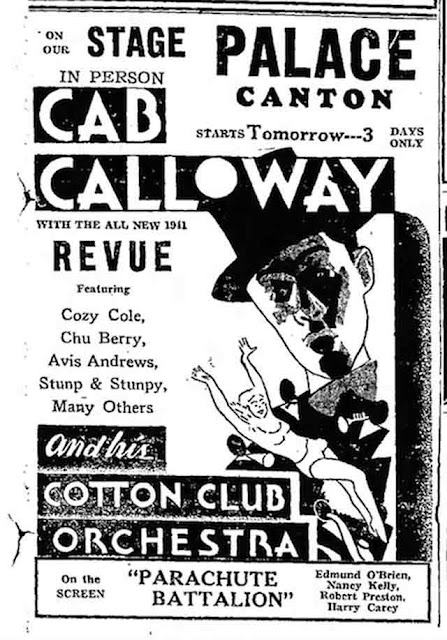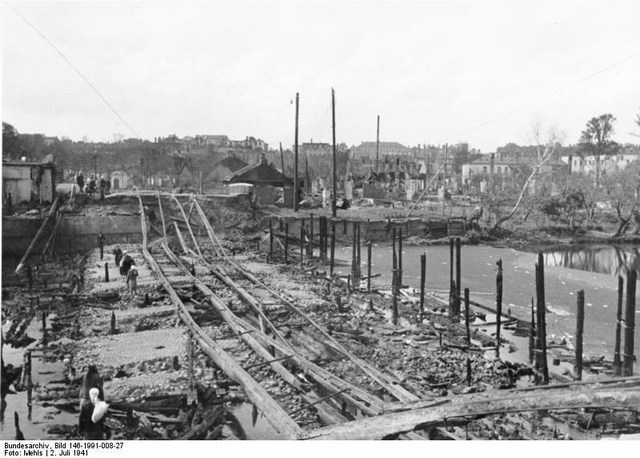Wednesday 2 July 1941
 |
| Finnish troops with Soviet prisoners carrying a wounded comrade, 2 July 1941 (SA-Kuva). |
Eastern Front: The front is moving rapidly eastward on
2 July 1941, and the reference points have to adjust along with it. For the first time, the Dniepr River looms in the calculations of both sides. Hitler's 29 June "stop" order is withdrawn, so the major Reich goals of Leningrad, Moscow, and Kyiv again send the panzers forward as if they were magnets drawn to a scrapyard. Heavy rains along part of the front slow the German advance.
In the Far North sector, the Germans have been rebuffed by strong Soviet defenses at the base of the Rybachy peninsula during Operation Silver Fox. So, General Dietl in the command of Army of Norway has shifted troops from there to the advance east toward the Litsa River. These new additions enable the Germans to fight through fierce Soviet resistance to the Litsa. However, going is slow and Soviet reinforcements are gradually stiffening the defense.
Operation Arctic Fox, the advance by German and Finnish troops toward Salla and ultimately the Murmansk railway line, bogs down. The Soviets counterattack SS Nord Division during daylight and stop the SS men cold. In a pattern of very uneven performance by SS units that recurs throughout the war, the SS staff panics and loses control. The troops, leaderless, flee to the rear. However, the XXXVI Corps staff finally regains control of the troops before a serious problem develops. The Army of Norway staff decides it needs to reinforce the advance with regular army troops.
In the Army Group North sector, the panzers of the 4th Panzer Group attack the Stalin Line. The leading panzers are halfway to Leningrad and still gaining ground at a rapid clip.
In the Army Group Center sector, new Western Front commander Marshal Timoshenko is under orders from the Stavka to defend the Western Dvina River-Dniepr River line. In the north, General Hoth's 3rd Panzer Group faces rainy weather and makes only a little ground to the outskirts of Polotsk. In the center, General Guderian's 2nd Panzer Group (18th Panzer Division) takes Borisov from the remnants of the 13th Army and the Borisov Tank School. Guderian's tankers capture a key road bridge intact despite Soviet General Eremenko's personal orders to destroy it.
In the southern part of the central sector, the SS Motorized Division "Das Reich" also captures a bridgehead across the Berezina when it takes Pogost, but the German XXIV Motorized Corps has less luck. The Soviet 4th Army's Rifle Divisions are overwhelmed there, but they manage to destroy bridges at the Berezina, Ola, Dobosna and Drut Rivers.
In the Army Group South sector, Romanian 3rd and 4th Armies march with the German 11th Army into Soviet Moldavia. This is Operation München. The Soviet Southern Front counterattacks, but are beaten off. Their objectives are the Prut and then the Dniester Rivers.
Future Luftwaffe ace Oblt. Gerhard Barkhorn of 6./JG 52 files his first victory claim. Heinz Bär of JG 51, who has 27 victories, is awarded the Ritterkreuz and promoted to Lieutenant.
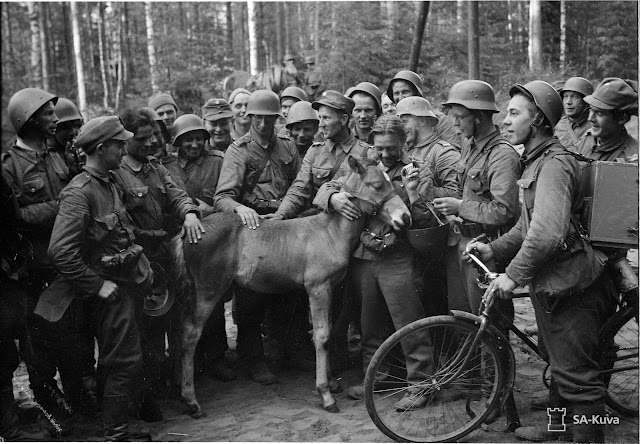 |
| Finnish troops, 2 July 1941 (SA-Kuva). |
Syrian/Lebanon Campaign: Following the loss of Sukhna to the Arab legion, the Vichy French in Palmyra fear being outflanked. So, after a lengthy and hard-fought battle in which they have held their own, the French surrender during the night of 2 July. Habforce now has an open road west to Homs 40 miles to the west and, ultimately, the coast near Beirut.
Off the coast, Australian light cruiser HMAS Perth and light cruiser HMS Naiad, along with escorting destroyers, shell the French positions at Damur. During this operation, the RAF mistakenly attacks the Perth, but miss.
Vichy French aircraft bomb the Royal Navy port of Haifa.
European Air Operations: The RAF sends a Circus mission (Bristol Blenheim bombers with a heavy fighter escort) against the railway yards and airfield at Lille. The raid is notable because the escorting fighters include the American-volunteer "Eagle Squadron" (RAF No. 71 Squadron of No. 11 Group, based at RAF North Weald). American William J. Hall becomes the first Eagle Squadron pilot to become a POW when he is shot down, and perhaps the first American serviceman to enter a POW camp during World War II.
During the Circus mission, the RAF loses four bombers and eight fighters. Obstlt. Adolf Galland claims his 70th victory, a Blenheim bomber. Others getting victories include
- Hptm. Rudolf Bieber of Stab I./JG 26 for his first kill (bomber)
- Fw. Günther Seeger of the Stab./JG 2 (bomber)
- Oblt. Josef "Pips" Priller of 1./JG 26 for his twenty-ninth
- Hptm. Gerhard Schöpfel of III./JG 26 for his twenty-seventh
- Hptm. Rolf Pingel of I./JG 26 for his twenty-second
- Oblt. Walter Schneider of 6./JG 26 for his fourteenth
- Ofw. Rudolf Täschner of 1./JG 2 for his thirteenth
- Lt. Horst Ulenberg of 2./JG 26 for his tenth
- Lt. Bruno Stolle of 8./JG 2
- Fw. Heinz Jahner of 9./JG 2
- Oblt. Hans-Jürgen Hepe of 4./JG 2.
The Luftwaffe loses four planes, but all four pilots survive and return to their units. Galland's plane is badly damaged and he is injured, but he is able to return to the airfield. He is saved from death by extra armor recently added to this cockpit.
During the night, RAF Bomber Command bombs Bremen (67 bombers), Köln (Cologne, 42 bombers), and Duisburg (39).
Wing Commander Douglas Bader receives the Bar to his Distinguished Service Order (DSO). Later in the day, Bader claims one Bf 109 fighter destroyed and another damaged.
 |
| A building burning during Finnish offensive operations, 2 July 1941 (SA-Kuva). |
Battle of the Baltic: In the Irben Strait (linking the Gulf of Riga with the Baltic Sea), Soviet destroyer Strashny hits a mine and is badly damaged while on a minelaying mission. Two other destroyers, Serdity and Silny, go on to lay their mines.
Both sides conduct minelaying operations in the Baltic.
Battle of the Atlantic: During the night of 1/2 July, the RAF scores a hit on German heavy cruiser Prinz Eugen. The hit destroys the command room in the center of the ship and puts it out of action for the remainder of 1941.
Minelayer HMS Plover lays minefield BS 66 in the North Sea.
Convoy OB-341A departs from Liverpool for Halifax.
Canadian patrol vessel HMCS Talapus is launched in Victoria, B.C.
Battle of the Mediterranean: The siege of Tobruk continues. On both sides, there is occasional shelling, but overall the enemy is boredom rather than military action. For the Australians in Tobruk, water is a key concern. Nobody can shave, and occasional expeditions to watering holes after dark are a must. The heat is overbearing, and flies are everywhere.
Royal Navy submarine HMS Torbay torpedoes and sinks 2933-ton Italian freighter Citta Di Tripoli north of Kea Island.
Swordfish of RAF No. 830 Squadron and Wellington bombers raid Tripoli after dark. The Swordfish lay mines at the harbor entrance and damage 1724-ton German freighter Sparta and 2517-ton Italian freighter Eritrea. In addition, the Wellingtons start several fires and damage some smaller vessels.
 |
| Refugees fleeing on a Panje Wagon which carries all of their belongings (Mehls, Federal Archives, Bild 146-2004-0221). |
War Crimes: Advancing Wehrmacht troops discover 153 bodies of German Infantry Regiment 35 in a clover field near the town of Broniki in western Ukraine. This is the Broniki Massacre. The soldiers note that the bodies "have been slaughtered in a bestial manner and were mutilated." A few members of the slaughtered group are found and provide evidence to a Wehrmacht investigation. The surviving prisoners describe how the Soviets forced them to undress and then took them to a field and shot everyone. They also reveal that the Soviets used hand grenades and bayonets to murder prisoners. The German investigation reveals similar incidents happening elsewhere along the front; apparently, the Soviets choose not to take prisoners.
POWs: French Lieutenant Pierre Mairesse Lebrun makes a successful escape from Oflag IV-C at Colditz Castle. He does not engage in any elaborate plans that other prisoners are contemplating, but instead simply leaps a wire fence and then scales an outer brick wall. Lebrun eventually makes it to Switzerland.
Spy Stuff: The Japanese are trying to get top-secret maps of US defenses in the Panama Canal Zone back to Tokyo. However, they fear actually trying to remove the maps from the Zone because airline crews are searching every piece of luggage. Following on several other subtle diplomatic attempts to change this policy, Japanese Foreign Minister Matsuoka instructs the Japanese minister in Mexico City to complain to the Guatemalan government about the practice. The Japanese hope, through this roundabout practice, to get the Pan American Airways crews to respect Japanese diplomatic privileges and not search their luggage - so that the Canal Zone diplomats can smuggle the militarily sensitive maps out.
 |
| A Wehrmacht soldier guards a column of Soviet prisoners in Minsk, 2 July 1941 (Federal Archive, Bild 146-1982-077-11). |
Applied Science: The MAUD Committee (apparently the initials stand for nothing, though some ascribe them to the British Military Application of Uranium Detonation) is a collection of top Allied scientists. Their mission is to determine the feasibility of using nuclear technology to create a bomb. Today, they have a meeting to discuss the committee's final report.
The committee decides to divide its lengthy MAUD Report into two separate reports: a lengthy "Use of Uranium for a Bomb"; and a shorter "Use of Uranium as a Source of Power." The former report states in its opening paragraph:
We have now reached the conclusion that it will be possible to make an effective uranium bomb which, containing some 25 lb of active material, would be equivalent as regards destructive effect to 1,800 tons of TNT and would also release large quantities of radioactive substances which would make places near to where the bomb exploded dangerous to human life for a long period.
The report creates a strong rationale for the formation of the Manhattan Project that develops the first atomic bombs. Its influence is widespread, leading directly to nuclear weapons programs not only in the United States but also in the United Kingdom and the Soviet Union (through copies obtained by spies).
Japanese/Soviet Relations: The Japanese send assurances to Soviet Ambassador to Japan Constantin Smetanin that they do not intend to join the Reich in its war against the Soviet Union.
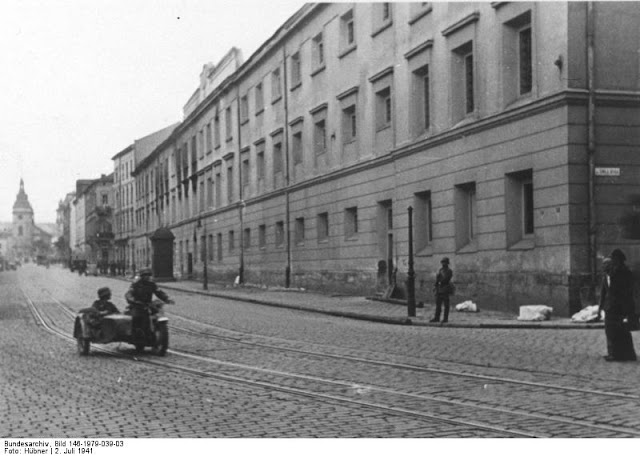 |
| The NKVD secret police prison in Lviv (Lvov), 2 July 1941 (Hübner, Federal Archive, Bild 146-1979-039-03). |
German Military: German 2nd Army, moving from the Balkans, sets up its headquarters in Army Group Center. Its absence from the Eastern Front to date has not affected operations.
Soviet Military: Stalin is frustrated with the conduct of the war so far, so today he makes some more major changes. He appoints old hand Semyon Konstantinovich Timoshenko, Marshal of the Soviet Union and People's Commissar for Defence, to command the Western Front, with Eremenko and Marshal Semyon Budyonny (aka Budenny, the commander of the Group of Reserve Armies) as his deputies. This is the command that defends the approaches to Moscow, which already is coming into view as a battleground following the fall of Minsk.
Stalin also moves five armies, 16th Army, 19th Army, 20th Army, 21st Army and 22nd Army, from Budyonny's reserve forces and moves them up to the Smolensk region. Continuing his purge of army commanders that he sees as lacking, Stalin orders the arrest of 4th Army commander Lieutenant General Aleksander Andreevich Korobkov. Along with General of the Army Pavlov, disgraced former head of Western Front, Korobkov is charged with numerous offenses and faces the death sentence, and a finding of guilt is always a foregone conclusion in the USSR under Stalin.
 |
| Western Approaches Command at Derby House, July 1941."The switchboard controlling the teleprinter machines. On receiving a signal that there is a message to transmit, the operator on the switchboard plugs in the appropriate teleprinter machine in the adjoining room." © IWM (A 4541). |
Japanese Military: Japan recalls all merchant shipping from the Atlantic Ocean. The Imperial Japanese Army calls up more than a million army conscripts, with 400,000 allocated to China and the remainder set aside for future operations in southeast Asia. Emperor Hirohito attends a conference at which war minister Hideki Tojo advocates an aggressive policy to secure territory following the German example. The conference ratifies Tojo's plan to take more control over French Indochina. The Emperor, bound by protocol, cannot say anything and merely accepts his ministers' proposals.
Japanese Government: Foreign Minister Yosuke Matsuoka issues a
statement immediately after the conference held in the presence of Emperor Hirohito. Obviously, it does not reveal the real decisions made at the conference about focusing military efforts to the south, particularly in French Indochina. However, it does convey the seriousness of the decisions made there regarding future Imperial policy:
As announced by the Government today, an important national policy has been decided upon at a council held in the Imperial presence... I feel that a really grave state of super-emergency is developing before our eyes the world over as well as in East Asia, with the affairs of which our nation is directly concerned. The more serious the situation the more calm and composed must our nation be, and with a nationwide unity we must, in response to the August Will of His Imperial Majesty, endeavor not to make even the slightest deviation from the path along which our nation is to march forward.
Japan, he states, is watching the German-Soviet War closely, but gives no hint that the country feels any need to intervene.
Canadian Military: The military institutes the Canadian Women's Auxiliary Air Force.
Holocaust: German special forces in the company of local Lithuanians begin to execute up to 100,000 civilians in Reichskommissariat Ostland. This is the Ponary Massacre, which lasts off and on through August 1944. It is named for the place where many of the executions take place, the railway station of Ponary (Paneriai) near Vilnius, Lithuania. The bulk of the people executed are Jews, with a few Poles and about 8000 Soviet POWs.
Another incident begins in Riga. Local police are incited to murder 400 Jews and burn down all of Riga's synagogues.
Riots break out in Lviv, Ukraine against racist laws.
American Homefront: Gary Cooper film "Sergeant York" opens at the Astor Theater in New York City with York himself, Eleanor Roosevelt, General John Pershing, and other luminaries in attendance. "Sergeant York," a tale of the eponymous World War I hero Alvin C. York, goes on to become a huge box office success. It also stars Walter Brennan, Noah Berry Jr., Howard Da Silva, and a young June Lockhart. "Sergeant York" aids the war effort by encouraging recruiting and is used to sell war bonds. Cooper goes on to win the Best Actor Oscar.
New York Yankee Joe DiMaggio is in Yankees Stadium for a game against the Boston Red Sox. Joe's brother, Dom, is the center fielder for the Sox, and Dom makes one of the best catches of his career to rob Joe of an extra-base hit. In his third at-bat, Joe gets a home run off Dick Newsome. This gives Joe DiMaggio a hit in 45 straight games. This sets a new major league record, breaking Wee Willie Keeler's previous record set in 1897.
The first live television game show premieres on the new CBS Television network called "CBS Television Quiz." The show features contestants given answers and asked to supply the questions - a format later made legendary on Merv Griffin show "Jeopardy.". CBS Television Quiz is the first game show to be broadcast regularly on television (there were occasional one-shot game show broadcasts in the 1930s such as "Spelling Bee" on the BBC in 1938). The show features host Gil Fates and scorekeeper Frances Buss. The live show runs weekly from today through 25 May 1942, with 47 episodes total. The shows are not taped or photographed in any fashion and are completely lost.
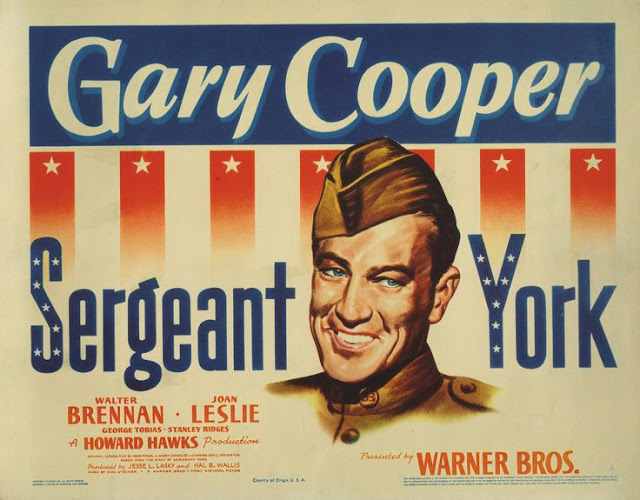 |
| Movie poster for "Sergeant York," which opens on 2 July 1941. |
July 1941July 1, 1941: US TV Broadcasting StartsJuly 2, 1941: MAUD ReportJuly 3, 1941: Stalin SpeaksJuly 4, 1941: Pogroms in Eastern EuropeJuly 5, 1941: Germans on ScheduleJuly 6, 1941: Australians Attack DamourJuly 7, 1941: US Marines in IcelandJuly 8, 1941: Flying Fortresses In ActionJuly 9, 1941: British Take DamourJuly 10, 1941: Sword and Scabbard OrderJuly 11, 1941: Cease-fire in Syria and LebanonJuly 12, 1941: Anglo/Russian Assistance PactJuly 13, 1941: Uprising in MontenegroJuly 14, 1941: Katyusha Rocket Launchers in ActionJuly 15, 1941: Smolensk FallsJuly 16, 1941: Stalin's Son CapturedJuly 17, 1941: Heydrich Orders Mass ExecutionsJuly 18, 1941: Twin Pimples RaidJuly 19, 1941: V for VictoryJuly 20, 1941: The Man Who Wouldn't ShootJuly 21, 1941: Moscow in FlamesJuly 22, 1941: Soviet Generals ExecutedJuly 23, 1941: Secret Plan JB 355July 24, 1941: Operation SunriseJuly 25, 1941: US Naval AlertJuly 26, 1941: Italian E-Boat Attack on MaltaJuly 27, 1941: MacArthur ReturnsJuly 28, 1941: Auschwitz ExterminationsJuly 29, 1941: Rescue From CreteJuly 30, 1941: Raid on Petsamo and KirkenesJuly 31, 1941: Final Solution Order2020







